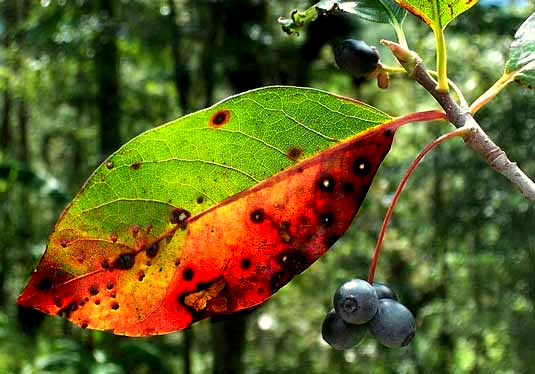
First of all, why are most leaves green during the summer?
It's because the main service leaves provide to individual plants is that of using solar energy to photosynthesize food for the plant. That chemical process requires chlorophyll molecules, which are green pigments causing leaf greenness.
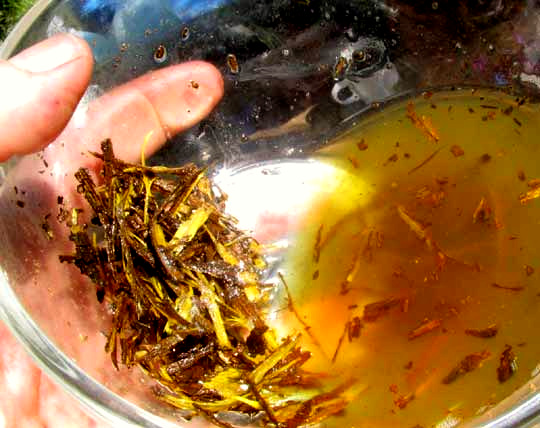
However, as indicated in the above picture of a color-changing leaf of the Black Tupelo tree, Nyssa sylvatica, pigments come in many colors. Also, as indicated by the picture at the left, pigments of various colors often can be soaked from various parts of a plant, not just leaves. The picture shows pigments in orangish Berberis dye being soaked from woodchips of the woody bush Agarita, Berberis trifoliolata. In plants, pigments are formed during many kinds of chemical reactions in different parts of the plant body, and the pigment molecules can take the form of many different classes of organic compounds. The topic of color change in leaves is a big one which can only be touched on briefly here.
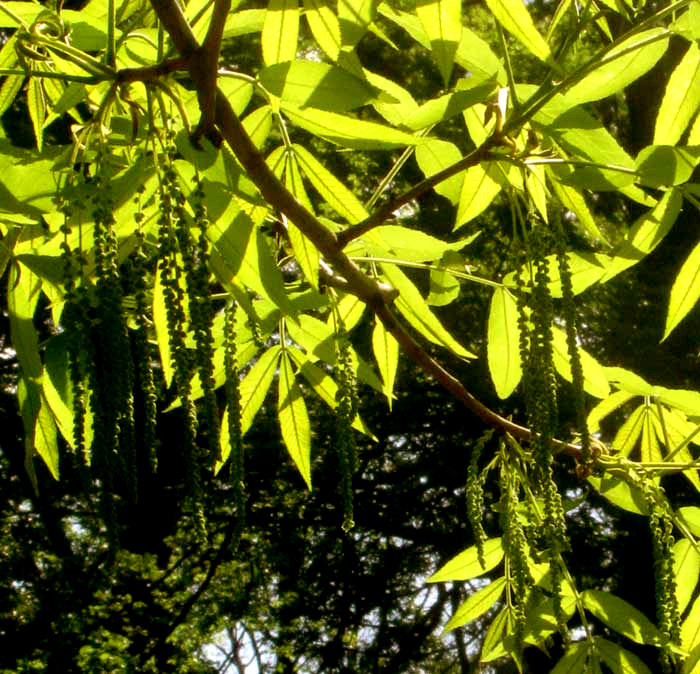
With regard to leaf colors, it's important to keep in mind that sunlight consists of many colors. When sunlight falls onto a glass prism, the prism reflects a rainbow spectrum of colors. It happens that a leaf's chlorophyll pigment absorbs mainly the red and blue part of the color spectrum. Therefore, at the right, the light coming into our eyes from sunlight-drenched, vigorously photosynthesizing leaves of Pignut Hickory, Carya glabra, is mostly GREEN, though there's a good bit of yellow in it, too.
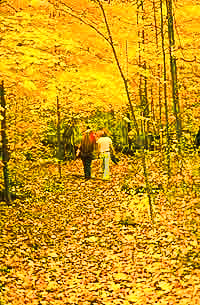
Speaking of yellowness, normally in green leaves there's another pigment known as carotene, though the green chlorophyll usually masks it. Carotene is a kind of "chlorophyll helper." It absorbs sunlight energy like chlorophyll, but instead of using the energy itself, it passes it on to chlorophyll, which then uses it during photosynthesis. Carotene holds up much better under sunlight than chlorophyll, so often in the fall when chlorophyll fades from leaves, carotene is left behind. Since carotene absorbs blue-green and blue light, the light coming into our eyes is YELLOW, or, with a little red thrown in, golden.
Too much sunlight can damage skin, fade colors in clothing and cause other problems, so it's not surprising that sunlight also causes chlorophyll molecules to break down. In fact, during the summer, green plants continually create new chlorophyll to replace destroyed molecules. This creation, or synthesis, of chlorophyll requires not only sunlight but also warmth, so when fall's cool weather comes, chlorophyll synthesis diminishes, revealing other more sunlight-resistant pigments that have been there all along, but were masked by green chlorophyll.
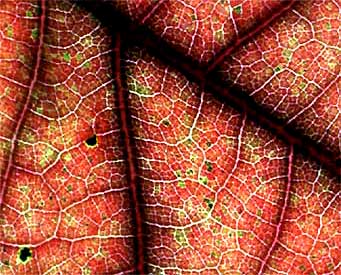
Another pigment, or class of pigments, occurring in many leaves such as in the late-fall leaf of the Black Oak, Quercus velutina, shown at the right, are called anthocyanins. Anthocyanins aren't involved with photosynthesis, but rather form when sugars and certain proteins interact in the sap within plant cells. Despite playing no part in photosynthesis, anthocyanins aren't formed unless sunlight is present. Since anthocyanins absorb blue, blue-green, and green light, the color they transmit to our eyes is RED.
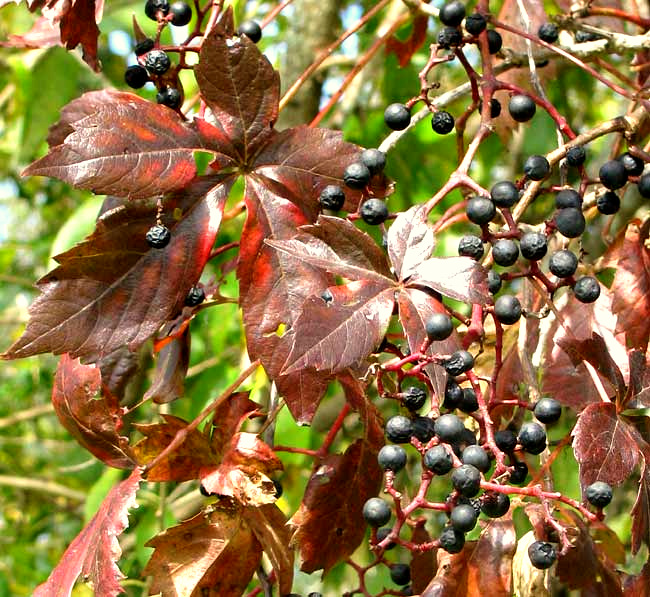
In terms of color expression, something interesting about anthocyanins is that they're sensitive to the pH, or degree of acidity, of the sap in which they exist inside plant cells. If the sap is very acidic, anthocyanin imparts a bright red, but if the sap is less acidic, its color is more PURPLE, as seen at the left with the Virginia Creeper vine, Parthenocissus quinquefolia.
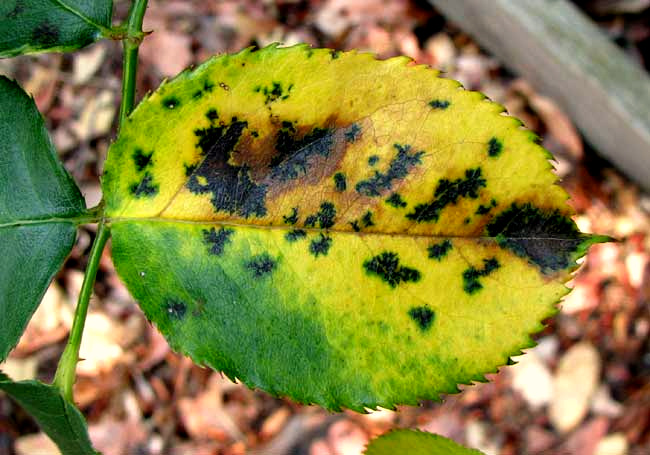
Changes in leaf color also can be brought about by diseases. At the right, you see a leaflet on an ornamental rose bush suffering from the very common, mostly late-summer appearing disease called Black Spot Disease. It's caused by the fungus Diplocarpon rosae, and it causes leaf-color changes. Fungal spores germinate in the blackish areas, then within the leaf fungal hyphae penetrate cell after cell, making conditions for the survival of green, relatively fragile chlorophyll molecules impossible. As chlorophyll disappears, more resilient yellow carotene pigment remains, coloring infected leaf parts yellow. Eventually even the carotene dies, leaving dead, blackened tissue.
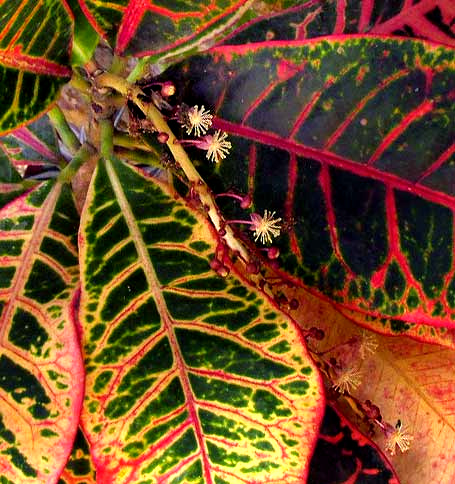
Many ornamental plants bear especially colorful leaves, such as the Variegated Croton, Codiaeum variegatum, seen at the left. A 2015 study by P.Magdalita and others assumes that the the Variegated Croton's wild ancestral form probably was or is green-leafed. However, hundreds of cultivars have been created from this species, resulting in many plant sizes, leaf shapes and, especially, leaf colors and patterns. In general, wild green plants need their leaves for photosynthesis, so if their leaves have large surface areas where pigments other than chlorophyll dominate, the plants are less able to compete for sunlight than their neighbors, and may disappear. Cultivars, however, cared for by humans, can get by with displaying such colors.
You may be interested in joining The Foliage Network, which keeps a close watch on fall leaf colors in the eastern US.
The USDA Forest Service has a page focusing on fall colors in US National Forests.